Abstract: In order to meet the testing needs of automotive manufacturers for automotive electronic products, an implementation method of automotive electronic detection system based on CAN bus and embedded technology is proposed. Taking the test instrument of USB car audio entertainment system as an example, the method is explained in detail. Firstly, the basic structure of hardware design is given, and the circuit design of CAN bus controller and driver is described. Secondly, the layering of software design is described. The structure uses Wince as the operating system of the instrument, and specifically analyzes the implementation of the CAN bus driver in Wince. Finally, the specific process of the upper application is described. The USB component test instrument has been successfully applied in on-site production and has achieved good results. Practice has shown that this test method is an effective solution to meet the testing needs of automotive manufacturers.
Keywords: automotive electronics; CAN bus; embedded system; test instrument
This article refers to the address: http://
The automobile industry is the pillar industry of the country, and the electronics industry is also the pillar industry of the country. As the intersection of the automobile industry and the electronics industry, the rise and fall of the automotive electronic parts industry is closely related to the national economy. At present, the output of China's automobiles is rising year by year. While the national automobile brand continues to grow, it also forces international automobile companies or joint ventures to reduce production costs and implement the localization strategy of automotive electronic components. This is the industrialization of China's automotive electronics. The development provides a good opportunity.
In addition to its complex functional requirements, pre-installed automotive electronics products are very strict in terms of real-time, safety, reliability and environmental protection, and automotive manufacturers have their own relevant inspection standards and production process specifications. It is very necessary to develop the corresponding fault detection system for the front-loading of automotive electronic products.
1 system design
1.1 Design basis CAN bus is a serial car bus. It has the advantages of simple structure, high reliability and mature technology. It has been widely used in the automotive field. The pre-installed automotive electronics must follow the CAN communication protocol of the specific model. Almost all control and status information of the vehicle depends on the CAN bus transmission. By collecting and analyzing the signals on the CAN bus, the working status and real-time of each component can be accurately obtained. Parameters, this is the basic basis of automotive electronic test systems.
The general requirements of automotive manufacturers for test equipment include real-time, reliability, portable and friendly human-computer interaction. Due to its flexible hardware and software design, good reliability and real-time performance, and low power consumption, embedded systems can fully meet the requirements of manufacturers for test instruments. Therefore, CAN-based frame testing and embedded design are effective solutions for automotive electronic test systems.
1.2 Implementation scheme Embedded automotive electronic test system, generally choose 32-bit microprocessor with better performance, such as ARM processor, including hardware module, storage module, human-computer interaction module, etc. According to the CAN bus communication, the corresponding CAN bus communication module must be designed. In this module, it usually consists of two parts, one is the CAN controller, which is used to realize the data link layer protocol of the CAN bus; the other part is the CAN driver for realizing The physical layer of the CAN bus. The basic structure of the system is shown in Figure 1.
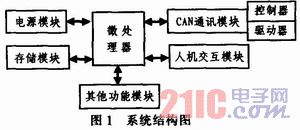
Automotive electronic test equipment generally requires friendly human-computer interaction, and the requirements for interface design are relatively high. Therefore, layered software design methods should be adopted in software design. In general, it is necessary to transplant related embedded operating systems. Embedded operating systems mainly include Linux, Wince, and so on. The software design process mainly includes three stages: operating system porting, driver writing, and application design. Porting a suitable embedded operating system to build a development platform for software development; developing related drivers to support hardware devices and providing interfaces for application software access hardware. In CAN modules, it is generally necessary to develop support controllers and drivers. Drivers to facilitate communication with automotive electronics; applications are the top-level software that directly faces the user and provides friendly interaction for user use.
2 System Design Example Based on the above system analysis, a specific design example explanation is given. The USB car audio playback system is a front-mounted automotive electronics product developed for an automobile manufacturer. The product strictly complies with the CAN bus protocol provided by the manufacturer in communication. This test system is mainly used for fault detection before parts leave the factory.
2.1 Hardware design Considering the requirements of performance, power consumption, stability, etc., Intel's 32-bit industrial-grade microprocessor PXA270 is selected. The processor is based on ARM10 core and runs at a frequency of up to 520M-Hz. The addition of IntelSpeedStep dynamic power management technology minimizes device power consumption while maintaining CPU performance. This processor simplifies hardware design and ensures fast software operation; the memory module uses 64 MB of NorFlash and 64 MB SDRAM; human-computer interaction uses liquid crystal display and touch control solutions.
In the design of the CAN bus communication module, the chips used are SJA1000, PCA82C250 and TJA1055. SJA1000 is a stand-alone CAN controller released by PHLIPS for automotive and general industrial environments. SJA1000 is an alternative to PCA82C200 controller. In addition to supporting BasicCAN operation mode, it also adds a new operating mode PeliCAN. CAN2.0B protocol with many new features. The SJA1000 is used in the CAN hardware module to implement the data link layer protocol of the CAN bus. In this design, two SJA1000 chips are used for high-speed CAN and low-speed CAN communication. The specific circuit schematic of SJA1000 is shown in Figure 2. The data buses AD0~AD7 are connected to the data bus MD0~MD7 of PXA270 through the data buffer device. The timing control and other signal lines are connected to the CPLD, and the PXA270 processor passes the CPLD. management.
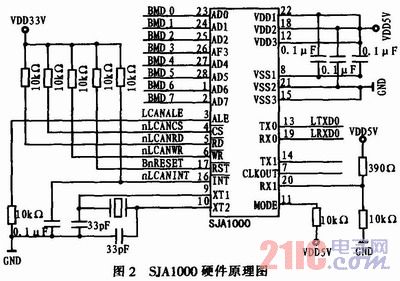
Both the PCA82C250 and TA1055 drive transceivers are used to implement the physical layer of the CAN bus. The difference is that the two chips each implement two standards of the CAN physical layer: high-speed CAN and low-speed CAN. High-speed CAN provides a baud rate of up to 1 Mbit/s depending on the cable length. Low-speed CAN provides a baud rate of 5 to 125 kbit/s, and allows the CAN bus to continue communication when the connection fails, so it is also called fault tolerance. CAN, the instrument supports two physical standards, the circuit diagram of the driver is shown in Figure 3. HTXD0, HRXD0 and LTXD0, LRXD0 are all from SJA1000. After PCA82C250 and TJA1055, high-speed CAN channels HCHNH, HCHNL and low-speed CAN channels LGANH and LCANL are obtained respectively.
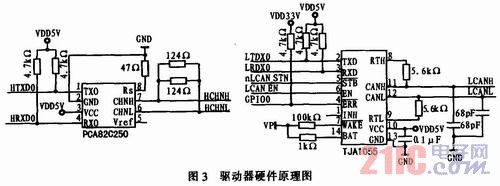
2.2 Software Design Considering that manufacturers have higher requirements for human-computer interaction, and in order to shorten the development cycle, Microsoft Windows CE is selected as the embedded operating system. Wince is a compact, complete and extensible embedded operating system. It is a multi-threaded, priority-based preemptive operating system with memory management that can suppress the risk of directly destroying the system due to abnormal application. It is suitable for hardware platforms with limited resources, and Wince's operating system inherits the style of desktop Windows system in interface operation, which is convenient for the familiarity and use of operators.
The main work of software design includes the transplantation of Wince5.0 system on PXA270, CAN bus, LCD display, touch screen, Flash storage, Bluetooth and other driver implementation, CAN protocol implementation and application design.
Wince drivers are mainly divided into native drivers and stream interface drivers. Native drivers are hardware-required drivers. They do not support general-purpose device driver interfaces, such as touch-screen drivers. Stream interface drivers refer to drivers that use streaming interface functions. Open out, regardless of the type of device that the driver controls. The driver of CAN bus is mainly the software support of controller SJA1000. It is a typical stream interface driver in wince. It realizes the function of SJA-1000 through CAN_Init, CAN_Open, CAN_Close, CAN_Read, CAN_Write, CAN_IOControl, CAN_Deiit and other functions; among them CAN_Init mainly Complete the initialization of SJA1000, CAN_Open is used to respond to application requests, CAN_Read and CAN_Write are used to read and write characters from the CAN bus, CAN_IOControl is used to extend other functions, CAN_Close is used to close the response, CAN_Deiit is used to release Resources and uninstall drivers.
The application was developed using Embedded Visual C++ 4.0. The test instrument has many tasks. Most of the tests are based on the analysis of the CAN frame sent by the component. The main test functions of the instrument include: audio left and right channel test, microphone test, Bluetooth test, USB test and so on. The software flow of the system is shown in Figure 4. The main interface of the system is shown in Figure 5.
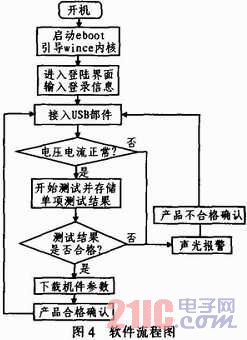
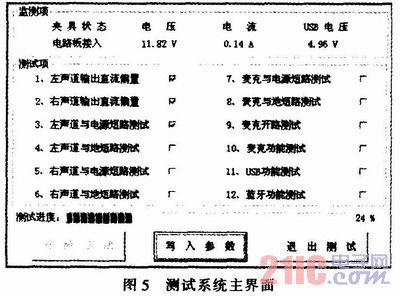
2.3 Field application The test instrument has been used in on-site production to perform pre-shipment quality testing on USB car audio playback components. Practice shows that the test instrument is fast, reliable and user-friendly. Each machine can detect 300-500 per working day. The detection accuracy of the parts is over 99%, which fully meets the needs of the manufacturers.
3 Conclusion This paper proposes an automotive electronic test method based on CAN communication and CAN frame analysis for the specific needs of automotive electronics development. The field application shows that this method is a fast and effective method for testing pre-installed automotive electronic products. The embedded automotive electronic test equipment meets the requirements of the manufacturer for volume, price, speed, reliability, etc., and will continue to be widely used in the front-mounted automotive electronic products developed in the future.
custom logo:please send me your logo,and we will printed them on the credit Card USB Flash Drive which is a good idea of your company to do promotion gifts,This item is very popular.
The best gifts for company promotion/Wedding gift,you can not miss this card usb in such situation.
Selling Point:
1.We promise all USB Flash Drive is real full capacity.
2.The chip 100% test before production.
3.Free design for custom logo.
4.Free sample for small capacity ,just pay for the shipping cost.
USB Flash Drive Card,Card USB Flash Drive,USB Business Card,USB Pen Drive
Custom Usb Gift company limited , http://www.customusbgift.com
